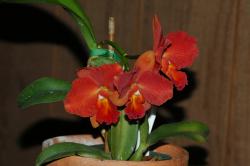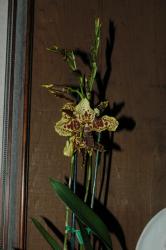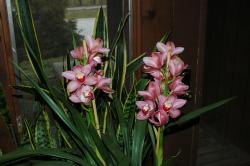May your holidays be warm and happy. May the New Year bring you whatever good the old year failed to deliver!
So, Merry Christmas, Happy Hanukkah, a Merry Yule, Winter Solstice, Saturnalia! I may have missed a few. In any case, this is winter in the Northern Hemisphere, a time that tends to be bleak and uncomfortable if left to itself. Our flowers are deserting us, so let's be thankful for our friends.
We wish all the best for you, your families, and your friends.
Jim & Irma Shields
Now to the greenhouse, or rather to Hoosier Orchid Company's greenhouses. I've neglected my little collection of orchids badly over the past 5 years, and so I've lost most of them. For some reason, we didn't visit Hoosier Orchids last year. So yesterday, we drove over to the northwest corner of Indianapolis, on West 82nd Street, to visit Hoosier Orchids. Harley Rhodehamel, the owner's father, was the one we knew; Harley has passed away, but his son's orchids are still there!
My excuse for going was that I had run out of the fine mesh orchid potting mix I use and which I always get from Hoosier Orchids. The real reason was to see what they had in bloom!

Slc. Sun Rise Doll
Irma liked this little dwarf cattleya type: Slc. Sun Rise Doll (Slc. = Sophrolaeliocattleya) with its 2½-inch red flowers. We bought it. They had several other dwarf cattleya types as well, some with mostly yellow flowers. The name is in grex format, so this is probably one of a batch of similar seedlings.

Degarmoara Flying High 'Hawaii'
I like the Oncidium types, and they had quite a selection of mostly yellow to almost pure, deep, purple-brown. I bought this one: Dgmra. Flying High 'Hawaii' (Dgmra. = Degarmoara = Brassia x Miltonia x Odontoglossum). This one is a clone, so the plants were likely propagated in tissue culture.

Cymbidium, pink hybrid
Finally we decided on this Cymbidium hybrid as well. This is what I would call a "medium sized" Cymbidium. The leaves and scapes are 25 to 30 inches tall. Besides this rosy pink color, they had cymbidiums with rich green flowers and several plants with very pale, creamy pink flowers. I didn't see any grex or clone names on the cymbidiums.
Having brought two bags of the fine mesh orchid mix home, I've now set to work repotting my old surviving orchids and trying to salvage as much of them as I can. You really need to repot orchids more often that once in every 5 to 10 years!
I found three spikes started on the plants I was repotting. Now that was a very nice surprise. We'll see how they do, since I repotted two of the three anyway. I'll hold the third until after it has finished flowering.
I've an old Cattleya hybrid that was a huge mess, mostly dead and dried up old stems, roots and pseudobulbs. I chopped it up into living sections as best I could, but I'll be surprised if any of those divisions survive. And there are still several more plants to go.....
Good gardening,
Jim